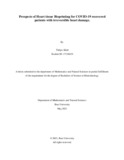| dc.contributor.advisor | Naser, Iftekhar Bin | |
| dc.contributor.advisor | Promon, Salman Khan | |
| dc.contributor.author | Akter, Fariya | |
| dc.date.accessioned | 2021-09-13T06:48:19Z | |
| dc.date.available | 2021-09-13T06:48:19Z | |
| dc.date.copyright | 2021 | |
| dc.date.issued | 2021-05 | |
| dc.identifier.other | ID: 17136019 | |
| dc.identifier.uri | http://hdl.handle.net/10361/14998 | |
| dc.description | This thesis is submitted in partial fulfillment of the requirements for the degree of Bachelor of Science in Biotechnology 2021. | en_US |
| dc.description | Catalogued from PDF version of thesis. | |
| dc.description | Includes bibliographical references (pages 44-62). | |
| dc.description.abstract | Endomyocardial biopsy of COVID-19 patients myocardium proves the presence of viral particles
along with the cardiogenic shock. 78 out of 100 recovered individuals who take 71 days of
treatment had cardiovascular involvement despite recovering from COVID-19. 76% of them had
high sensitivity troponin which is an indicator of myocardial damage and 60% had myocardial
inflammation, edema, and/or diffuse myocardial fibrosis. Besides, the recently recovered patient’s
report reflects ventricular ejection fraction.
Due to multiple mutations of the causative agent SARS-CoV-2, it’s still a mystery how we can
defeat the virus. Numerous complications are associated with COVID-19 and studies found the
association of cardiovascular complications in every individual despite the age consideration,
recently. Cardiovascular complications are responsible for sudden cardiac death of both the
infected and recovered COVID-19 patients along with long-term cardiovascular effects as
damaged myocardial tissues are unable to regenerate and few portions of damaged myocardium
can induce damage to the whole heart.
The purpose of this research is to do a competitive analysis of the conventional tissue engineering
techniques with the upgraded alternative 3D bioprinting to replace the damaged portion of the
human heart due to COVID-19. Additionally, this study focuses on the key points for the
regeneration of a functional, biocompatible heart that mimics the native heart and the potential of
3D bioprinting to be a novel alternative. Finally, the limitations and current challenges of these
techniques are briefly discussed. | en_US |
| dc.description.statementofresponsibility | Fariya Akter | |
| dc.format.extent | 62 Pages | |
| dc.language.iso | en_US | en_US |
| dc.publisher | Brac University | en_US |
| dc.rights | Brac University theses are protected by copyright. They may be viewed from this source for any purpose, but reproduction or distribution in any format is prohibited without written permission. | |
| dc.subject | COVID-19 | en_US |
| dc.subject | Irreversible heart tissue damage | en_US |
| dc.subject | Regenerative medicine | en_US |
| dc.subject | 3D Bioprinting | en_US |
| dc.title | Prospects of Heart tissue Bioprinting for COVID-19 recovered patients with irreversible heart damage. | en_US |
| dc.type | Thesis | en_US |
| dc.contributor.department | Department of Mathematics and Natural Sciences, Brac University | |
| dc.description.degree | B. Biotechnology | |

